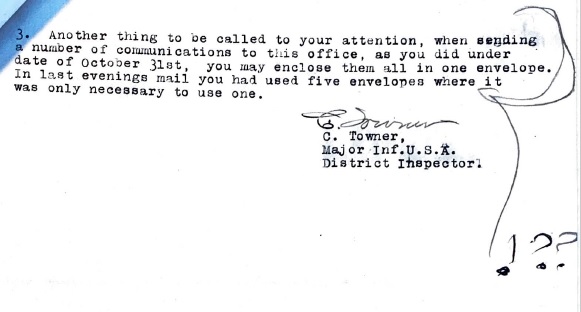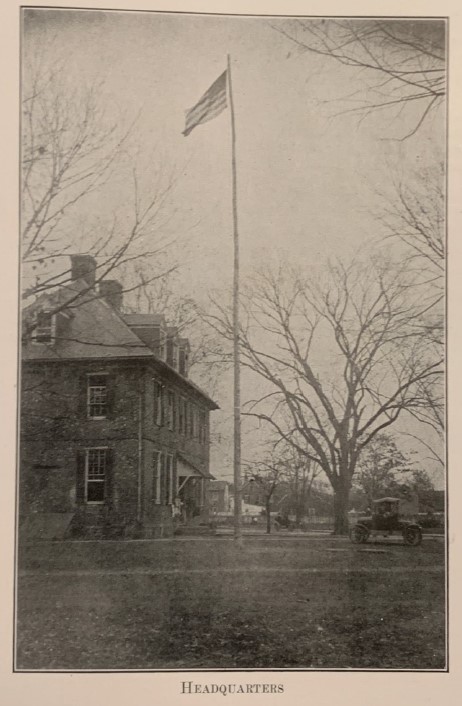In addition to dealing with supply issues, Captain Van Dusen also had a slew of administrative troubles. Haven taken over for Major Stone, Van Dusen was thrown into command with hardly any instruction from Major Stone or the CEST. On October 16, Van Dusen sent a memo to the CEST’s District Military Inspector in North Carolina requesting help on how to properly fill out the bi-weekly reports.1 More importantly, he writes,

In his response two days later, the District Military Inspector only wrote four lines; two explaining the proper process for the bi-weekly reports and “Memos numbering up to #29 have so far been sent out by the Committee on Education and Special Training.”2 Despite working for the CEST, the District Military Inspector provided little help for Van Dusen.
Van Dusen’s troubles with the CEST would continue. On October 17, he sent a memo to a Lt. Bump at the University of North Carolina (UNC) Chapel Hill requesting help in figuring out which paperwork needed to go to the District Military Inspector, the CEST, and the US Army Eastern Department Headquarters.3 Though not stated in the memo, Lt. Bump is most likely an officer at the SATC unit at UNC Chapel Hill, given his rank. Regardless, the fact that Van Dusen went through informal channels to request help, rather than writing directly to the District Military Inspector or the CEST indicates the lack of administrative support for the SATC unit at William & Mary.
Even when requesting supplies, Captain Van Dusen ran into administrative red tape. On October 31, Van Dusen sent a requisition request to the CEST’s District Inspector, Major C. Towner, for blank requisition forms, barracks bags and an American flag. At the bottom of the memo, Van Dusen noted that he had no requisition forms to use. Two days later, he received a reply which stated that he would be sent requisition forms first and then he had to use them to request the additional supplies in his previous memo. Additionally, Van Dusen received comments about the placement of his signature and his use of envelopes.4


Van Dusen’s frustrations with Major Towner and the CEST are clearly expressed by his annotations on the section about the use of too many envelopes.
In spite of all the hardship Captain Van Dusen put up with in dealing with the administrative side of the SATC and CEST, his men noted and appreciated his dedication and that of the other officers in the unit. A section on TAPS, a yearbook produced by and for members of the William & Mary SATC, focuses on the Orderly Room, the unit headquarters, stating that,
In the Orderly Room all rules and regulations are drafted, all appointments considered and made, drill schedules prescribed, inspections made and reports entered, daily records kept, questions answered, delinquents attended to, etc. Vast quantities of orders, bulletins, memorandums, etc. are received from the War Department, Committee on Education and Special Training, Eastern Department Headquarters and the District Military Inspector . . . Here red tape holds sway and everything must be done according to complicated regulations, or trouble ensues immediately. One order may be changed as many as fifteen or twenty times in whole or in part, and the Orderly Room must keep all these changes straight.5

The section in TAPS continues, stating that,

It is clear from this section of TAPS that the men recognized the difficulties that their commanding officer, Captain Van Dusen, and his staff went through and appreciated their hard work.
Notes:
- Memo from Lt. Van Dusen to District Military Inspector dated October 16, 1918, National Archives RG 165 NM-84 Entry 412 Box 681.
- Memo from Lt. Van Dusen to District Military Inspector dated October 16, 1918, National Archives RG 165 NM-84 Entry 412 Box 681.
- Memo from Lt. Van Dusen to Lt. Bump dated October 17, 1918, National Archives RG 165 NM-84 Entry 412 Box 681.
- Memo from Lt. Van Dusen to CEST dated October 31, 1918, National Archives RG 165 NM-84 Entry 412 Box 682 Folder 2
- TAPS” Published in the Memory of The Students’ Army Training Corps at William and Mary College (Williamsburg, Virginia, 1918), 15.
- TAPS” Published in the Memory of The Students’ Army Training Corps at William and Mary College (Williamsburg, Virginia, 1918), 16.